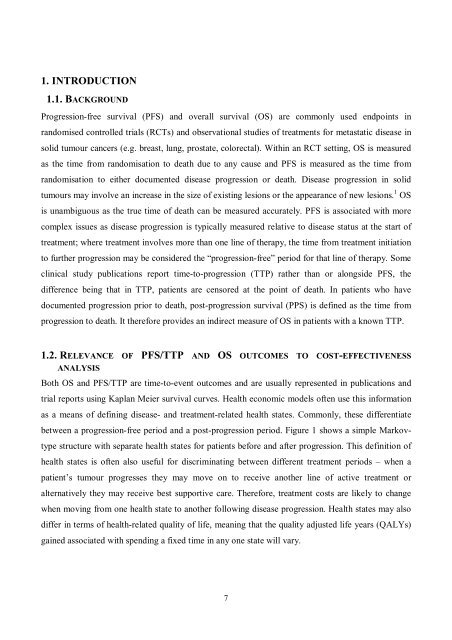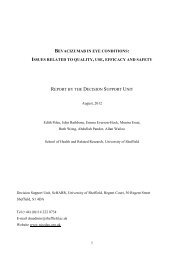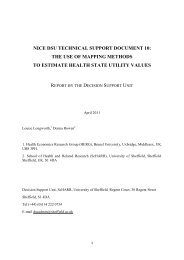A review of studies examining the relationship between progression ...
A review of studies examining the relationship between progression ...
A review of studies examining the relationship between progression ...
Create successful ePaper yourself
Turn your PDF publications into a flip-book with our unique Google optimized e-Paper software.
1. INTRODUCTION1.1. BACKGROUNDProgression-free survival (PFS) and overall survival (OS) are commonly used endpoints inrandomised controlled trials (RCTs) and observational <strong>studies</strong> <strong>of</strong> treatments for metastatic disease insolid tumour cancers (e.g. breast, lung, prostate, colorectal). Within an RCT setting, OS is measuredas <strong>the</strong> time from randomisation to death due to any cause and PFS is measured as <strong>the</strong> time fromrandomisation to ei<strong>the</strong>r documented disease <strong>progression</strong> or death. Disease <strong>progression</strong> in solidtumours may involve an increase in <strong>the</strong> size <strong>of</strong> existing lesions or <strong>the</strong> appearance <strong>of</strong> new lesions. 1 OSis unambiguous as <strong>the</strong> true time <strong>of</strong> death can be measured accurately. PFS is associated with morecomplex issues as disease <strong>progression</strong> is typically measured relative to disease status at <strong>the</strong> start <strong>of</strong>treatment; where treatment involves more than one line <strong>of</strong> <strong>the</strong>rapy, <strong>the</strong> time from treatment initiationto fur<strong>the</strong>r <strong>progression</strong> may be considered <strong>the</strong> “<strong>progression</strong>-free” period for that line <strong>of</strong> <strong>the</strong>rapy. Someclinical study publications report time-to-<strong>progression</strong> (TTP) ra<strong>the</strong>r than or alongside PFS, <strong>the</strong>difference being that in TTP, patients are censored at <strong>the</strong> point <strong>of</strong> death. In patients who havedocumented <strong>progression</strong> prior to death, post-<strong>progression</strong> survival (PPS) is defined as <strong>the</strong> time from<strong>progression</strong> to death. It <strong>the</strong>refore provides an indirect measure <strong>of</strong> OS in patients with a known TTP.1.2. RELEVANCE OF PFS/TTP AND OS OUTCOMES TO COST-EFFECTIVENESSANALYSISBoth OS and PFS/TTP are time-to-event outcomes and are usually represented in publications andtrial reports using Kaplan Meier survival curves. Health economic models <strong>of</strong>ten use this informationas a means <strong>of</strong> defining disease- and treatment-related health states. Commonly, <strong>the</strong>se differentiate<strong>between</strong> a <strong>progression</strong>-free period and a post-<strong>progression</strong> period. Figure 1 shows a simple Markovtypestructure with separate health states for patients before and after <strong>progression</strong>. This definition <strong>of</strong>health states is <strong>of</strong>ten also useful for discriminating <strong>between</strong> different treatment periods – when apatient’s tumour progresses <strong>the</strong>y may move on to receive ano<strong>the</strong>r line <strong>of</strong> active treatment oralternatively <strong>the</strong>y may receive best supportive care. Therefore, treatment costs are likely to changewhen moving from one health state to ano<strong>the</strong>r following disease <strong>progression</strong>. Health states may alsodiffer in terms <strong>of</strong> health-related quality <strong>of</strong> life, meaning that <strong>the</strong> quality adjusted life years (QALYs)gained associated with spending a fixed time in any one state will vary.7





